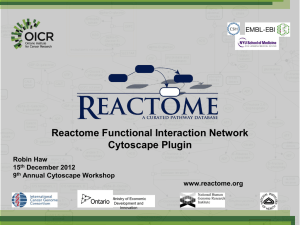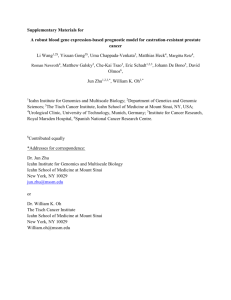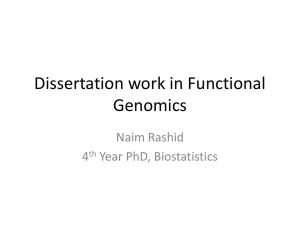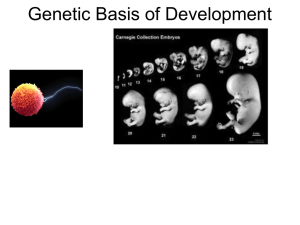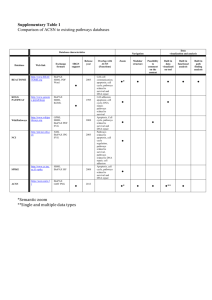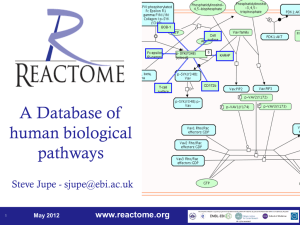bit25620-sup-0003-SupData-S1
advertisement
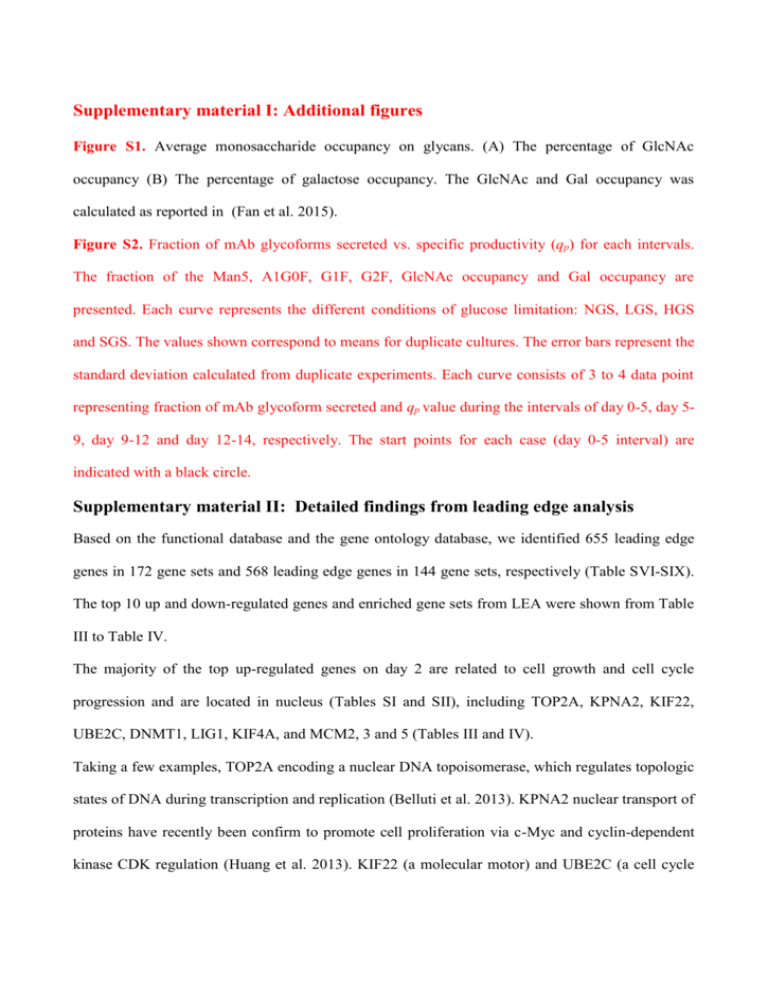
Supplementary material I: Additional figures Figure S1. Average monosaccharide occupancy on glycans. (A) The percentage of GlcNAc occupancy (B) The percentage of galactose occupancy. The GlcNAc and Gal occupancy was calculated as reported in (Fan et al. 2015). Figure S2. Fraction of mAb glycoforms secreted vs. specific productivity (qp) for each intervals. The fraction of the Man5, A1G0F, G1F, G2F, GlcNAc occupancy and Gal occupancy are presented. Each curve represents the different conditions of glucose limitation: NGS, LGS, HGS and SGS. The values shown correspond to means for duplicate cultures. The error bars represent the standard deviation calculated from duplicate experiments. Each curve consists of 3 to 4 data point representing fraction of mAb glycoform secreted and qp value during the intervals of day 0-5, day 59, day 9-12 and day 12-14, respectively. The start points for each case (day 0-5 interval) are indicated with a black circle. Supplementary material II: Detailed findings from leading edge analysis Based on the functional database and the gene ontology database, we identified 655 leading edge genes in 172 gene sets and 568 leading edge genes in 144 gene sets, respectively (Table SVI-SIX). The top 10 up and down-regulated genes and enriched gene sets from LEA were shown from Table III to Table IV. The majority of the top up-regulated genes on day 2 are related to cell growth and cell cycle progression and are located in nucleus (Tables SI and SII), including TOP2A, KPNA2, KIF22, UBE2C, DNMT1, LIG1, KIF4A, and MCM2, 3 and 5 (Tables III and IV). Taking a few examples, TOP2A encoding a nuclear DNA topoisomerase, which regulates topologic states of DNA during transcription and replication (Belluti et al. 2013). KPNA2 nuclear transport of proteins have recently been confirm to promote cell proliferation via c-Myc and cyclin-dependent kinase CDK regulation (Huang et al. 2013). KIF22 (a molecular motor) and UBE2C (a cell cycle regulators) have been reported to be involved in cell division (Mocciaro and Rape 2012; Yu et al. 2014). Additionally, MCM2, 3 and 5 are implicated in the formation of replication forks during DNA replication (Bell and Dutta 2002). These findings are in agreement with the results from the enrichment maps in figure 7 and the nature of the cells in early growth phase. On the other hand, the top up-regulated genes on day 9 are located at membrane and extracellular region (Tables SI) and are mainly involved in extracellular matrix regulation, cell proliferation and apoptosis, protein secretions, lipid transport and glycosylation (Tables III and IV). COL5A2 and COL7A1 regulate the expression of collagens may cause alterations in extracellular matrix (Liu et al. 2010). Previous studies also show that change in the expression of COL5A2 was observed in sodium butyrate treated CHO cells based on the mRNA-seq data (Birzele et al. 2010). Additionally, PLG were also shown to participant in degradation of extracellular matrix (Rossignol et al. 2004). MMP12 functioning in extracellular matrix degradation, were found to be released from CHO cells producing recombinant factor VIII during the production phase (Sandberg et al. 2006). VAMP3 has been postulated to be a component of early/recycling endosomal v-SNARE responsible for protein trafficking and secretion and may contribute to extracellular matrix degradation (Kean et al. 2009). Taking all these into consideration, the change in extracellular matrix may be a physiological characteristic of cells in early stationary phase. Highly regulated apoptosis seems to be another molecular feature during the early stationary phase. ANXA1 belongs to annexin protein family, can bind phospholipid in a calcium-dependent manner, which was demonstrated to be essential for cell proliferation and apoptosis (McKanna 1995; Wu et al. 2000). It was also suggested to be in association with sustaining high productivity of recombinant protein over the duration of a CHO fed-batch culture (Meleady et al. 2011). LGALS1 and LGALS3 code for Galectin-1 and Galectin-3, respectively. Galectins are types of lectins that bind β-galactosides. Galectin-1 has been demonstrated to play different roles in cell survival and proliferation as a mitogen, a cell proliferation inhibitor, or a cell apoptosis promoter (Scott and Weinberg 2002). Similarly, Galectin-3 was also found to have a biological function in regulating cell proliferation and apoptosis (Nakahara et al. 2005). Also notably, the expression of sialidase-1 (encoded by NEU1) that cleaves terminal sialic acid residues from glycans is up-regulated in the early stationary phase. This is the likely basis of the report that decreased sialylation of recombinant proteins correlates with the increased culture duration (Chee Furng Wong et al. 2005). Table SI. Up and down regulated gene sets on day 2 comparing to day 9 using gene ontology databases. Size: numbers of genes consist in enriched gene set; NES: normalized enrichment sore of enriched gene set; NoM p: normalized p value of enriched gene set; FDR q: false positive rate of enriched gene set. GENE SET DNA Binding Nucleus Nuclear Part RNA Processing Cell Cycle Chromosome Nuclear Lumen Nucleobase/nucleoside/nucleotide and Nucleic Acid Metabolic Process Nucleoplasm RNA Metabolic Process Endopeptidase Activity Tissue Development Membrane Extracellular Region Part Plasma Membrane Part Plasma Membrane Cellular Lipid Metabolic Process Extracellular Region Receptor Binding Lipid Metabolic Process SIZE 76 283 122 47 59 29 71 NES 2.661 2.586 2.557 2.494 2.391 2.388 2.383 NoM p 0 0 0 0 0 0 0 FDR q 0 0 0 0 0 0 0 227 2.376 0 0 48 148 24 15 262 29 100 139 44 45 42 57 2.299 2.29 -1.959 -1.961 -1.963 -1.963 -2.005 -2.066 -2.078 -2.111 -2.126 -2.277 0 0 0 0 0 0 0 0 0 0 0 0 0 0 0.006 0.006 0.008 0.007 0.006 0.003 0.003 0.002 0.002 0 Table SII. Up and down regulated gene sets on day 2 comparing to day 9 found in functional database. Size: numbers of genes consist in enriched gene set; NES: normalized enrichment sore of enriched gene set; NoM p: normalized p value of enriched gene set; FDR q: false positive rate of enriched gene set. GENE SET Reactome mRNA processing Reactome processing of capped intron containing pre-mRNA Reactome RNA splicing KEGG spliceosome KEGG cell cycle Reactome transcription Reactome cell cycle mitotic Reactome RNA Polymerase II Transcription Reactome DNA repair Reactome Transcription-coupled NER (TC-NER) Reactome platelet activation signaling and aggregation Reactome phospholipid metabolism KEGG fatty acid metabolism KEGG PPAR signaling pathway KEGG ECM receptor interaction Reactome metabolism of lipids and lipoproteins Reactome sphingolipid metabolism KEGG focal adhesion Reactome extracellular matrix organization KEGG lysosome SIZE 50 44 32 43 30 41 81 31 25 15 49 38 17 17 15 104 16 50 17 38 NES 2.704 2.643 2.55 2.539 2.459 2.399 2.312 2.295 2.272 2.255 -1.965 -1.989 -1.999 -2.005 -2.109 -2.126 -2.137 -2.237 -2.238 -2.603 NoM p 0 0 0 0 0 0 0 0 0 0 0 0 0 0 0 0 0 0 0 0 FDR q 0 0 0 0 0 0 0 0 0 0 0.007 0.006 0.006 0.006 0.003 0.003 0.003 0 0.001 0 References Bell SP, Dutta A. 2002. DNA REPLICATION IN EUKARYOTIC CELLS. Annual Review of Biochemistry 71(1):333-374. Belluti S, Basile V, Benatti P, Ferrari E, Marverti G, Imbriano C. 2013. Concurrent inhibition of enzymatic activity and NF-Y-mediated transcription of Topoisomerase-II[alpha] by bisDemethoxyCurcumin in cancer cells. Cell Death Dis 4:e756. Birzele F, Schaub J, Rust W, Clemens C, Baum P, Kaufmann H, Weith A, Schulz TW, Hildebrandt T. 2010. Into the unknown: expression profiling without genome sequence information in CHO by next generation sequencing. Nucleic Acids Research 38(12):3999-4010. Chee Furng Wong D, Tin Kam Wong K, Tang Goh L, Kiat Heng C, Gek Sim Yap M. 2005. Impact of dynamic online fed-batch strategies on metabolism, productivity and N-glycosylation quality in CHO cell cultures. Biotechnol Bioeng 89(2):164-77. Huang L, Wang HY, Li JD, Wang JH, Zhou Y, Luo RZ, Yun JP, Zhang Y, Jia WH, Zheng M. 2013. KPNA2 promotes cell proliferation and tumorigenicity in epithelial ovarian carcinoma through upregulation of c-Myc and downregulation of FOXO3a. Cell Death Dis 4:e745. Kean MJ, Williams KC, Skalski M, Myers D, Burtnik A, Foster D, Coppolino MG. 2009. VAMP3, syntaxin-13 and SNAP23 are involved in secretion of matrix metalloproteinases, degradation of the extracellular matrix and cell invasion. Journal of Cell Science 122(22):4089-4098. Liu Y, Taylor NE, Lu L, Usa K, Cowley AW, Jr., Ferreri NR, Yeo NC, Liang M. 2010. Renal medullary microRNAs in Dahl salt-sensitive rats: miR-29b regulates several collagens and related genes. Hypertension 55(4):974-82. McKanna JA. 1995. Lipocortin 1 in apoptosis: Mammary regression. The Anatomical Record 242(1):1-10. Meleady P, Doolan P, Henry M, Barron N, Keenan J, O'Sullivan F, Clarke C, Gammell P, Melville M, Leonard M and others. 2011. Sustained productivity in recombinant Chinese Hamster Ovary (CHO) cell lines: proteome analysis of the molecular basis for a process-related phenotype. BMC Biotechnology 11(1):78. Mocciaro A, Rape M. 2012. Emerging regulatory mechanisms in ubiquitin-dependent cell cycle control. Journal of Cell Science 125(2):255-263. Nakahara S, Oka N, Raz A. 2005. On the role of galectin-3 in cancer apoptosis. Apoptosis 10(2):267-275. Rossignol P, Ho-Tin-Noe B, Vranckx R, Bouton MC, Meilhac O, Lijnen HR, Guillin MC, Michel JB, Angles-Cano E. 2004. Protease nexin-1 inhibits plasminogen activation-induced apoptosis of adherent cells. J Biol Chem 279(11):10346-56. Sandberg H, Lutkemeyer D, Kuprin S, Wrangel M, Almstedt A, Persson P, Ek V, Mikaelsson M. 2006. Mapping and partial characterization of proteases expressed by a CHO production cell line. Biotechnol Bioeng 95(5):961-71. Scott K, Weinberg C. 2002. Galectin-1: A bifunctional regulator of cellular proliferation. Glycoconjugate Journal 19(7-9):467-477. Wu Y-L, Jiang X-R, Lillington DM, Newland AC, Kelsey SM. 2000. Upregulation of lipocortin 1 inhibits tumour necrosis factor-induced apoptosis in human leukaemic cells: a possible mechanism of resistance to immune surveillance. British Journal of Haematology 111(3):807-816. Yu Y, Wang X-Y, Sun L, Wang Y-L, Wan Y-F, Li X-Q, Feng Y-M. 2014. Inhibition of KIF22 suppresses cancer cell proliferation by delaying mitotic exit through upregulating CDC25C expression. Carcinogenesis.
